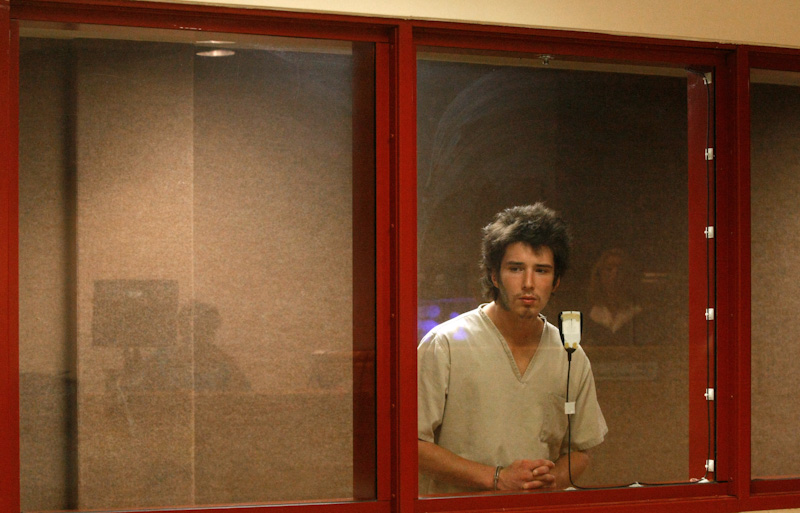Netflix's 'The Hatchet Wielding Hitchhiker' smashes the circumstantial evidence argument

Caleb Lawrence McGillvary is arraigned on murder charges in a jail courtroom in Elizabeth, New Jersey, in June 2013. McGillvary gained internet fame as “Kai the Hatchet-Wielding Hitchhiker.” (Photo by Patti Sapone/The Star Ledger)
If you remember the early days of memeworthy viral videos, you may remember Kai, a free-spirited hitchhiker who saved a woman on the streets from a another man’s violent attack.
The woman was in danger, “so I f- - -ing ran up behind him with a hatchet. Smash, smash, smash!” said the man, whose real name is Caleb Lawrence McGillvary, in a 2013 news clip that went viral.
At the time, he was seen as a good Samaritan, and over the next 100 days or so, he quickly took the world by storm. With appearances on Jimmy Kimmel Live! and offers for a reality series, the drifter with no last name had found fame.
But that fame quickly turned to infamy. Netflix’s The Hatchet Wielding Hitchhiker tells the story of a man experiencing homelessness, whose rise and fall overshadowed what may have been telltale signs of someone suffering from mental health issues.
Kai was upfront and proud of his nomadic existence. His nonconventional lifestyle lent even more credence to the joy that many saw in his immediate success. The success, though, was short-lived.
Turning of the tables
Although often clueless, The Office’s Michael Scott put it best—sometimes situations can flip in the blink of an eye, and Kai experienced that on both spectrums. Within three months of his newfound fame, he was arrested for murdering Joseph Galfy, a 73-year-old attorney in New Jersey.
Galfy’s body was found in his bedroom, severely beaten, wearing only socks and underwear.
Kai was quickly named a suspect. After all, a note in Galfy’s home with Kai’s name and number on it, along with a receipt for a train ticket, was found. Although not conclusive, the note and receipt became increasingly probative when surveillance footage from one of the local train stations showed Galfey buying Kai a ticket, with the two exchanging an embrace shortly before departing off-screen.
A manhunt was initiated, and Kai was subsequently found at a Greyhound station after a Philadelphia-area Starbucks barista recognized him and contacted police. Once arrested, Kai claimed that he had met Galfy, who invited him in and gave him a place to stay, only to drug and rape him.
Kai’s account was corroborated by a Facebook update that he posted as law enforcement was searching for him, which read in part: “What would you do if you woke up with a groggy head, metallic taste in your mouth, in a strangers house … realizing that someone had drugged [and] raped [you] … what would you do?”
Kai reiterated the sexual assault while speaking with law enforcement after he was captured and taken into custody.
The double standard of criminal investigations
I’ve previously written about the tunnel vision that law enforcement sometimes suffers. I’ve noted how it’s human nature to become invested in your case and want to see a successful outcome based on your hard work and dedication.
Is that the right approach for that profession? No. Is it understandable from a human psychology perspective? Yes.
What has to be explained, though, is the double standard that law enforcement often applies to achieve that outcome. I’ve had plenty of cases in which law enforcement, during their testimony and the prosecution, in closing arguments proclaim that a witness’s statements or social media posts describing their victimhood is strong evidence that the “victim” is being honest.
However, Kai didn’t get the same treatment. By all accounts, Kai stood by his version of events, specifically that Galfy drugged and raped him, and he beat Galfy in self-defense.
Moreover, The Hatchet Wielding Hitchhiker closes with one law enforcement officer’s commentary that: “Kai was trying to claim self-defense, but that’s not what the crime scene told us.” He also noted that Kai lacked defensive wounds or testimony from anyone who saw scratches, bruises, cuts or the like.
Indirect information
I can’t count the number of times that I’ve cross-examined law enforcement regarding a witness who claims that my client raped them, not having my client’s DNA under their fingers or exhibiting bruises, cuts, scratches or scrapes—only to be told that rape victims rarely exhibit visible defensive wounds.
But that’s the position you’re forced to take when evidence doesn’t include a confession or an objective firsthand witness directly tying the crime in question to the person you’re accusing. That brings up an interesting discussion about direct and circumstantial evidence.
Whether it’s a current client complaining about the prosecution’s case or a potential client selling their account during intake, it never fails: “All they have is circumstantial evidence.” I hear it at least once per month, if not once per week.
When I ask people to contrast the evidence that they are referencing with the direct evidence that they think is necessary, it becomes clear that circumstantial evidence is often a buzzword. In all honesty, most can’t define either. Here’s a quick and dirty primer I tell clients: Direct evidence directly proves a fact without requiring an inference, and circumstantial evidence infers that something happened but doesn’t necessarily prove it.
I’ve explained in multiple installments how, at Oklahoma jury trials, the judge instructs the jury that the law makes no distinction between direct and circumstantial evidence. However, I’ve never explained how I handle that at trial.
Prosecutors love to focus on circumstantial evidence during jury selection and bring it back up when the time for closing arguments comes. However, if they focus their arguments on this particular instruction, or even if you think that it might be a central topic of their last close, you can head it off by reminding the jury that saying something isn’t the same as proving it.
Circumstantial evidence can be compelling, if there is enough of it and it actually creates a link to the accused. As such, I remind the jury that it takes more than a few crumbs to reconstruct a cookie.
After all, evidence can be misleading, and motive isn’t something that a defendant leaves behind at the crime scene. Right, wrong or indifferent, that’s all that Kai has to hold onto these days.
At jury trial, he was convicted of Galfy’s murder and sentenced to 57 years in prison in 2019.

Adam Banner
Adam R. Banner is the founder and lead attorney of the Oklahoma Legal Group, a criminal defense law firm in Oklahoma City. His practice focuses solely on state and federal criminal defense. He represents the accused against allegations of sex crimes, violent crimes, drug crimes and white-collar crimes.
The study of law isn’t for everyone, yet its practice and procedure seems to permeate pop culture at an increasing rate. This column is about the intersection of law and pop culture in an attempt to separate the real from the ridiculous.
This column reflects the opinions of the author and not necessarily the views of the ABA Journal—or the American Bar Association.



